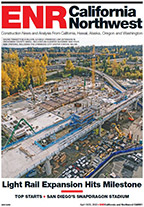Before the new $60-million San Jose Earthquakes Stadium can shake with more than 18,000 soccer fans, the construction team must finish removing all the underground World War II tank parts and factory components that were left behind by the site's previous occupants.
Once used to build Bradley infantry vehicles in the 1940s, the land for the new stadium came with no as-built blueprints, says Dave Kaval, president of the San Jose Earthquakes. As a result, crews led by Milpitas, Calif.-based Devcon Construction have spent the past six months digging up and demolishing more than 70 underground vaults, 50 wells and 250 massive underground pilings.
"We knew there was a 6-in. to 12-in. concrete slab over the whole [15-acre] area, but we didn't know what was underneath, and we had no concept it could be so elaborate and extensive," Kaval says.
Originally set to open in March, the stadium is now scheduled to open halfway through the team's season, in mid-2014.
The vaults, some originally built as bomb shelters, were nicknamed "icebergs" by the project team because there was no way of knowing how deep they went. Because many vaults went below the water line, water filled in and created a lake the size of two Olympic swimming pools during removal, says Kaval. To remedy this, thousands of tons of crushed rock were used to displace the water and compact the soil.
When finished, the stadium will boast a horseshoe-shaped seating bowl and cantilevered roof. Brad Schrock, principal in charge with 360 Architecture, San Francisco, says the roof will provide the shape of the mass. "We have this long roof to support, and we didn't want columns in the seating, so the last column in the back of the seats comes up through at the edge of the seat perimeter and supports the roof," he adds.





Post a comment to this article
Report Abusive Comment